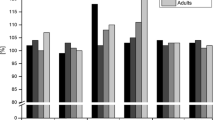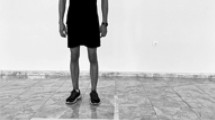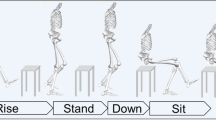Abstract
Anterior cruciate ligament (ACL) injury is associated with mechanical instability and defective neuromuscular function, and can lead to further injury, increased joint loading and osteoarthritis. Patients with ACL injury demonstrate altered postural orientation, manifested as observable “substitution patterns” (SPs) but no one has applied a clinically useful method to systematically study postural orientation in these patients. Here, we investigated the presence of such patterns in 24 adults with ACL injury and in 49 controls, in parallel with the development and a first evaluation of a new test battery, test for SPs. The rationale behind the test for SPs was to characterize postural orientation as the ability to maintain appropriate relationships between body segments and environment during weight-bearing movements. In this first study, patients displayed SPs more frequently and/or more clearly on their injured, but also their uninjured side than did controls. Inter-rater and intra-rater reproducibility was good at a group level. Future studies of validity, responsiveness and including other subgroups of patients with ACL injury will have to prove if the test for SPs can be used in the diagnostics of defective neuromuscular function following knee injury, when planning and carrying out training and rehabilitation and when deciding appropriate time to return to activity and sports after ACL injury.
Similar content being viewed by others
References
Ageberg E (2002) Consequences of a ligament injury on neuromuscular function and relevance to rehabilitation—using the anterior cruciate ligament-injured knee as model. J Electromyogr Kinesiol 12:205–212
Alkjaer T, Simonsen EB, Jorgensen U, Dyhre-Poulsen P (2003) Evaluation of the walking pattern in two types of patients with anterior cruciate ligament deficiency: copers and non-copers. Eur J Appl Physiol 89:301–308
Alkjaer T, Simonsen EB, Peter Magnusson S, Aagaard H, Dyhre-Poulsen P (2002) Differences in the movement pattern of a forward lunge in two types of anterior cruciate ligament deficient patients: copers and non-copers. Clin Biomech 17:586–593
Baratta R, Solomonow M, Zhou BH, Letson D, Chuinard R, D’Ambrosia R (1988) Muscular coactivation. The role of the antagonist musculature in maintaining knee stability. Am J Sports Med 16:113–122
Bjorklund K, Skold C, Andersson L, Dalen N (2006) Reliability of a criterion-based test of athletes with knee injuries; where the physiotherapist and the patient independently and simultaneously assess the patient’s performance. Knee Surg Sports Traumatol Arthrosc 14:165–175
Brunnekreef JJ, van Uden CJ, van Moorsel S, Kooloos JG (2005) Reliability of videotaped observational gait analysis in patients with orthopedic impairments. BMC Musculoskelet Disord 6:17
Bullock-Saxton JE (1994) Local sensation changes and altered hip muscle function following severe ankle sprain. Phys Ther 74:17–28
Bullock-Saxton JE, Janda V, Bullock MI (1994) The influence of ankle sprain injury on muscle activation during hip extension. Int J Sports Med 15:330–334
Chmielewski TL, Rudolph KS, Fitzgerald GK, Axe MJ, Snyder-Mackler L (2001) Biomechanical evidence supporting a differential response to acute ACL injury. Clin Biomech 16:586–591
de Vet HC, Terwee CB, Knol DL, Bouter LM (2006) When to use agreement versus reliability measures. J Clin Epidemiol 59:1033–1039
Eastlack ME, Arvidson J, Snyder-Mackler L, Danoff JV, McGarvey CL (1991) Interrater reliability of videotaped observational gait-analysis assessments. Phys Ther 71:465–472
Ebstrup JF, Bojsen-Moller F (2000) Anterior cruciate ligament injury in indoor ball games. Scand J Med Sci Sports 10:114–116
Fitzgerald GK, Axe MJ, Snyder-Mackler L (2000) A decision-making scheme for returning patients to high-level activity with nonoperative treatment after anterior cruciate ligament rupture. Knee Surg Sports Traumatol Arthrosc 8:76–82
Griffin LY, Albohm MJ, Arendt EA, Bahr R, Beynnon BD, Demaio M, Dick RW, Engebretsen L, Garrett WE Jr, Hannafin JA, Hewett TE, Huston LJ, Ireland ML, Johnson RJ, Lephart S, Mandelbaum BR, Mann BJ, Marks PH, Marshall SW, Myklebust G, Noyes FR, Powers C, Shields C Jr, Shultz SJ, Silvers H, Slauterbeck J, Taylor DC, Teitz CC, Wojtys EM, Yu B (2006) Understanding and preventing noncontact anterior cruciate ligament injuries: a review of the Hunt Valley II meeting, January 2005. Am J Sports Med 34:1512–1532
Grillner S, Markram H, De Schutter E, Silberberg G, LeBeau FE (2005) Microcircuits in action–from CPGs to neocortex. Trends Neurosci 28:525–533
Gustavsson A, Neeter C, Thomee P, Gravare Silbernagel K, Augustsson J, Thomee R, Karlsson J (2006) A test battery for evaluating hop performance in patients with an ACL injury and patients who have undergone ACL reconstruction. Knee Surg Sports Traumatol Arthrosc 14:778–788
Hewett TE, Myer GD, Ford KR, Heidt RS Jr, Colosimo AJ, McLean SG, van den Bogert AJ, Paterno MV, Succop P (2005) Biomechanical measures of neuromuscular control and valgus loading of the knee predict anterior cruciate ligament injury risk in female athletes: a prospective study. Am J Sports Med 33:492–501
Hewett TE, Zazulak BT, Myer GD, Ford KR (2005) A review of electromyographic activation levels, timing differences, and increased anterior cruciate ligament injury incidence in female athletes. Br J Sports Med 39:347–350
Horak FB, Henry SM, Shumway-Cook A (1997) Postural perturbations: new insights for treatment of balance disorders. Phys Ther 77:517–533
Houck JR, Wilding GE, Gupta R, De Haven KE, Maloney M (2007) Analysis of EMG patterns of control subjects and subjects with ACL deficiency during an unanticipated walking cut task. Gait Posture 25:628–638
Ireland ML (2002) The female ACL: why is it more prone to injury? Orthop Clin North Am 33:637–651
Johansson H, Sjölander P, Sojka P (1991) A sensory role for the cruciate ligaments. Clin Orthop Relat Res 268:161–178
Lohmander LS, Englund PM, Dahl LL, Roos EM (2007) The long-term consequence of anterior cruciate ligament and meniscus injuries: osteoarthritis. Am J Sports Med 35:1756–1769
Myer GD, Ford KR, Hewett TE (2005) The effects of gender on quadriceps muscle activation strategies during a maneuver that mimics a high ACL injury risk position. J Electromyogr Kinesiol 15:181–189
Noyes FR, Barber-Westin SD, Fleckenstein C, Walsh C, West J (2005) The drop-jump screening test: difference in lower limb control by gender and effect of neuromuscular training in female athletes. Am J Sports Med 33:197–207
Oberg U, Oberg B, Oberg T (1994) Validity and reliability of a new assessment of lower-extremity dysfunction. Phys Ther 74:861–871
Olsen OE, Myklebust G, Engebretsen L, Bahr R (2004) Injury mechanisms for anterior cruciate ligament injuries in team handball: a systematic video analysis. Am J Sports Med 32:1002–1012
Palmitier RA, An KN, Scott SG, Chao EY (1991) Kinetic chain exercise in knee rehabilitation. Sports Med 11:402–413
Risberg MA, Lewek M, Snyder-Mackler L (2004) A systematic review of evidence for anterior cruciate ligament rehabilitation: how much and what type? Phys Ther Sport 5:125–145
Roos EM (2005) Joint injury causes knee osteoarthritis in young adults. Curr Opin Rheumatol 17:195–200
Rudolph KS, Axe MJ, Buchanan TS, Scholz JP, Snyder-Mackler L (2001) Dynamic stability in the anterior cruciate ligament deficient knee. Knee Surg Sports Traumatol Arthrosc 9:62–71
Rudolph KS, Axe MJ, Snyder-Mackler L (2000) Dynamic stability after ACL injury: who can hop? Knee Surg Sports Traumatol Arthrosc 8:262–269
Rudolph KS, Snyder-Mackler L (2004) Effect of dynamic stability on a step task in ACL deficient individuals. J Electromyogr Kinesiol 14:565–575
Shumway-Cook A, Woollacott M (2007) Normal postural control. In: Sabatini P (ed) Motor control. Translating research into clinical practice, 3rd edn. Lippincott Williams & Wilkins, Philadelphia, Baltimore, pp 158–186
Solomonow M, Krogsgaard M (2001) Sensorimotor control of knee stability. A review. Scand J Med Sci Sports 11:64–80
Tegner Y, Lysholm J (1985) Rating systems in the evaluation of knee ligament injuries. Clin Orthop Relat Res 198:43–49
Thorstensson CA, Henriksson M, von Porat A, Sjodahl C, Roos EM (2007) The effect of eight weeks of exercise on knee adduction moment in early knee osteoarthritis—a pilot study. Osteoarthr Cartil 15:1163–1170
van Uden CJT, Bloo JKC, Kooloos JGM, van Kampen A, de Witte J, Wagenaar RC (2003) Coordination and stability of one-legged hopping patterns in patients with anterior cruciate ligament reconstruction: preliminary results. Clin Biomech 18:84–87
Wojtys EM, Huston LJ (1994) Neuromuscular performance in normal and anterior cruciate ligament- deficient lower extremities. Am J Sports Med 22:89–104
Acknowledgments
The authors are very grateful to late Dr. RTP Rose Zätterström, who designed the first version of the TSP. We are also very grateful to Dr. Jonas Björk for expert advice on statistics, to Associate Professor Anders Lindstrand and to Professor Jan Lexell for valuable contributions to design and acquisition of data in the early stages of the study. This work was supported by the Swedish National Centre for Research in Sports, Region Skåne, Ann-Mari and Ragnar Hemborg’s Research Foundation and by the Faculty of Medicine, Lund University, Sweden. Anna Trulsson and Martin Garwicz were funded by the Swedish Research Council, Projects no. 14015 (PI Martin Garwicz) and 60012701 (a Linné grant to the Neuronano Research Center), respectively.
Conflict of interest statement
The authors report no conflict of interest for this manuscript.
Author information
Authors and Affiliations
Corresponding author
Appendix
Appendix
Test for substitution patterns
A—Pelvic lift with support from one foot

Substitution patterns:
-
A1. Knee medial to the foot (knee not in line with hip and foot) on supported side
-
A2. Lateral displacement of hip–pelvis-region on the supported side
-
A3. Difficulty in lifting the seat 5 times/side
B—Body-weight-altering test

Substitution patterns:
-
B1. Increased pronation of supported foot
-
B2. Knee medial to the foot (knee not in line with hip and foot) on supported side
-
B3. Lateral displacement of hip–pelvis region on the supported side
-
B4. Displacement of trunk (for instance bending trunk forward or displacing trunk laterally) on supported side
-
B5. Displacement of arms (look at elbows) such as moving arms laterally or forward on supported side
C—Tip-toe standing knee flexion

Substitution patterns:
-
C1. Knee medial to the foot (knee not in line with hip and foot) on supported side
-
C2. Lateral displacement of hip–pelvis region on the supported side
-
C3. Displacement of trunk (for instance bending trunk forward or displacing laterally) on supported side
D—Rising up from half-kneeling

Substitution patterns:
-
D1. Body weight displaced to the front leg (despite instructions not to do so)
-
D2. Displacement of trunk (for instance bending trunk forward or trying to raise with extra help from arms) on supported side
E—Knee-flexion–extension standing on one leg

Substitution patterns:
-
E1. Increased pronation of supported foot
-
E2. Knee medial to the foot
-
E3. Lateral displacement of hip–pelvis region on supported side
-
E4. Displacement of trunk (for instance bending trunk exaggeratedly forward or displacing trunk laterally) on supported side
F—One-leg-standing bouncing on trampoline

Substitution patterns:
-
F1. Increased pronation of supported foot
-
F2. Knee medial to the foot (knee not in line with hip and foot) on supported side
-
F3. Lateral displacement of hip–pelvis region on supported side
-
F4. Displacement of trunk (bending trunk forward or displacing trunk laterally) on supported side
-
F5. Difficulty doing the exercise with flexibility in flexion–extension in the knee joint when bouncing (“stiff knee”)
-
F6. Head displaced; not in line with trunk
G—Forward lunge from stairs

Substitution patterns:
-
G1. Shorter stride
-
G2. Knee medial to the foot (knee not in line with hip and foot) on supported side
-
G3. Displacement of trunk (for instance bending trunk forward or displacing laterally) on supported side
-
G4. Subject tries to help out with support from hands or takes a more careful stride (sound muffled when foot meets floor)
-
G5. Avoids weight-bearing on hind leg during return
H—Walking backwards on treadmill

Substitution patterns:
-
H1. Limp
-
H2. Increased pronation of supported foot
-
H3. Circular movement with foot in swing phase
-
H4. Knee medial to the foot (knee not in line with hip and foot) on supported side
-
H5. Displacement of trunk (for instance bending trunk forward or displaced laterally) on supported side
-
H6. Displacement of arms (look at elbows) such as: moving arms laterally or forward on supported side
-
H7. “Heel-drop” when either side was weight-bearing (meaning; the whole foot met the treadmill on the supported leg instead of a step starting with support from the big-toe ending with heel-support)
J—Mini-squat

Substitution pattern:
-
J1. Displacement of bodyweight to either side
Starting positions (S) and performance (P)
Test A. Supine position: pelvic lift with support of one foot
S: Subject lying supine on a bench with pillow under head, one knee bent about 90° and foot placed on bench in line with hip and knee. Other leg pulled towards abdomen through flexion in hip and knee. Arms rested aside body. P: Instructions: “Push chin down towards chest, press the hollow of your back into the bench, lift seat up and down slowly 5 times.” Subject repeats the exercise in the same way with the other leg. Examiner standing at the head of and beside the bench.
Test B. Standing position: body-weight-altering test
S: Subject standing barefoot with feet a good hip-width apart. Hands placed on head. P: Instructions: “Alternate body weight from right to left leg at the same time as you bend the supporting leg slightly at ankle, knee and hip joints. Do this slowly alternating the right and the left leg; five times on each side. Look straight ahead.” Examiner standing in front of subject.
Test C. Tiptoe-standing position: tiptoe-standing knee flexion
S: Subject barefoot, standing tip-toe on one foot facing wall. Slight support from fingertips against wall in front of subject. P: Instructions: “Bend your knee slowly about this deep (demonstrating approx. 70º of knee flexion) without lowering the heel. Five repetitions.” Examiner standing behind and then beside subject.
Test D. Half-kneeling position: rising up from “half-kneeling”
S: Subject, without shoes on a mat, “half-kneeling” supported by right knee and with toes of right foot bent and on the mat (right hip in full extension, head and trunk vertical). Left foot placed in front of right foot on the mat (left knee and hip at about 90° of flexion). Body weight on right leg. P: Instructions: “Rise slowly with your body weight on the hind leg until knees are fully extended. Return to initial position. Five times on each leg.” To emphasize that the body weight should be placed on the hind leg, Examiner gives this instruction every time subject rises up. Examiner observing subject from behind and from the side.
Test E. Standing on one leg: knee flexion–extension
S: Subject standing on right foot beside a bench with left leg slightly raised from the floor, fingertips of left hand providing slight balance support on bench. P: Instructions: “Bend your right leg (demonstrating approx. 70° of knee flexion) and rise five times. Turn around and repeat the procedure on the left leg.” Examiner standing in front of and beside subject.
Test F. One-leg-standing: bouncing on a trampoline
S: Subject one-leg-standing on right foot on a trampoline close to wall, left side turned to wall, slight support from fingertips of left (then right) hand against wall. Left leg slightly elevated in hip and knee flexion. P: Instructions: “Bounce hard (but without leaving the trampoline with the supporting foot, in other words: do not jump and do no heel-ups) for about 20 s. Turn around and repeat on the left leg.” Examiner standing in front of and beside subject.
Test G. Forward lunge: forward lunge from stairs
S: Subject standing with shoes, on first step of a staircase (about 15 cm high). P: Instructions: “Take a long stride out onto the floor (about 80 cm from the step) with the right leg and land on the right foot with about 90° of flexion in the right knee (called “stride” in protocol), while the left foot remains on the step. Remain in this position for a moment, then return to the step with support mainly on the left leg (called “return” in protocol). Do this slowly, alternating the right and the left legs, five times on each side.” Examiner standing in front of and beside subject observing both the “stride” and the “return”.
Test H. Backwards walking: walking backwards on a treadmill
S: Subject walking backwards on treadmill at a rate of 25 min/km, barefoot with hands placed on top of the head, elbows pointing out sideways. (Practice for about 1 minute before the test was allowed.) P: Instructions: “Walk backwards for about 2 min.” Examiner standing in front of, beside and behind subject.
Test J. Mini-squat
S: Subject standing barefoot with feet a good hip-width apart. P: Instructions: “Bend your knees as if you were going to squat (minimum 90° of knee flexion), and rise up again five times”. Examiner standing in front of subject.
Rights and permissions
About this article
Cite this article
Trulsson, A., Garwicz, M. & Ageberg, E. Postural orientation in subjects with anterior cruciate ligament injury: development and first evaluation of a new observational test battery. Knee Surg Sports Traumatol Arthrosc 18, 814–823 (2010). https://doi.org/10.1007/s00167-009-0959-x
Received:
Accepted:
Published:
Issue Date:
DOI: https://doi.org/10.1007/s00167-009-0959-x




